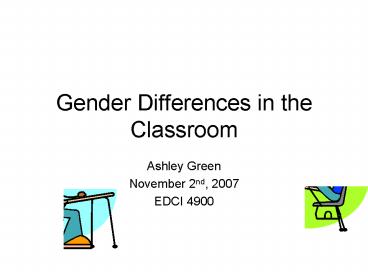Gender Differences in the Classroom - PowerPoint PPT Presentation
1 / 16
Title:
Gender Differences in the Classroom
Description:
I have chosen this topic because I am curious about the differences between male ... 'Girls get extra school help while boys get Ritalin.' USA Today. 28 August 2003. ... – PowerPoint PPT presentation
Number of Views:847
Avg rating:3.0/5.0
Title: Gender Differences in the Classroom
1
Gender Differences in the Classroom
- Ashley Green
- November 2nd, 2007
- EDCI 4900
2
Introduction
- I have chosen this topic because I am curious
about the differences between male and female
learning in the classroom. I think this is a big
issue in todays education system and it should
be addressed.
3
Overview
- This presentation will explain the differences
and learning styles of male and female students
in the classroom. It will also discuss how
teachers treat the different genders differently.
Same sex schools will also be addressed.
4
Differences in Boys Girls
- The Brain Develops Differently
- - The language area of the brain develops before
the spatial relations/geometry in girls - - In boys, it is the opposite.
- If you were not aware of the differences, a
teacher may assume the boys can not write and the
girls cant do math.
5
Differences in Boys Girls
- Areas of the Brain Mature Differently
- - Some of the regions involved in mechanical
reasoning and visual targeting mature four to
eight years earlier in boys. - - The parts that handle verbal fluency and
handwriting mature several years earlier in
girls.
6
Differences in Boys Girls
- The Brain is Wired Differently
- -In girls, emotion is processed in the same area
of the brain that processed language. - -In boys, the brain regions involved in talking
are separate from the regions involved in
feeling. - This is why girls are more open to talking about
their feelings.
7
Differences in Boys Girls
- Respond to Stress Differently
- - Stress enhances learning in males.
- - Stress impairs learning for females.
8
Different Learning Styles
- Girls- prefer cooperation, open-ended and
organized activities - Boys- prefer competition and individualism
- Teachers can apply these different learning
styles to their classroom to make it fair for
both genders.
9
Different Learning Styles
- In todays classroom, educators have developed
practices that favor the girls more than the
boys. - -Cooperative learning groups
- -Feminized literature
- -Personal essays
- -Gym/recess softer sports
10
Todays Classroom
- Boys in a typical classroom often develop
negative feelings toward school because the
teachers correct their boyish behavior and
teach a curriculum better suited to girls.
11
Same-Sex Schools
- Boys and girls are different, but one should not
be educated at the others expense. This is what
is happening with the boys in todays classroom. - Co-ed schools actually reinforce gender
stereotypes.
12
Same-Sex Schools
- Same-sex schools help improve student
achievement. - Fewer social and discipline problems are also a
result of same-sex schools. - The No Child Left Behind Act supports same-sex
classes and schools by allowing federal funds to
be used to develop and support same-sex programs.
13
Summary
- Boys and girls are very different in their
learning styles and their mental differences. In
todays classroom, there is a problem of showing
favoritism towards girls. This is affecting the
boys achievements. Same-sex schools is a good
solution to this problem and should be
implemented in more classrooms.
14
Websites
- National Association for Single Sex Public
Education (http//www.singlesexschools.org/home.ph
p) Offers information regarding federal funding,
research, history, and links to single-sex public
schools in the U.S. Link to Dr. Saxs research
(http//www.whygendermatters.com/) - U.S. Department of Education (http//www.ed.gov/in
dex.jhtml) Offers education information from the
United States education department. It has
information for students, parents, teachers, and
administrators. More opportunity in single-sex
classroom (http//www.ed.gov/news/pressreleases/20
06/10/10242006.html) - Commonwealth Education Organization
(http//www.ceopa.org/) Gives much information
on issues and problem in todays education.
Gender bias information (http//www.ceopa.org/Gen
der.html) - TEA (http//www.teateachers.org) Has a lot of
valuable information on the teaching world and
how to avoid gender bias in the classroom
(http//www.teateachers.org/teachctr/New20Teacher
/Avoiding20Bias20in20the20Classroom.pdf) - Scholastic (http//www2.scholastic.com/browse/home
.jsp) Has information about helping children and
teachers improve on reading skills. Gender
differences in learning (http//teacher.scholastic
.com/products/instructor/Mar04_gendergap.htm)
15
Print Resources
- Ripley, Amanda. Who Says a woman cant be
Einstein? TIME. 7 Mar 2005. p.55 - This article talks about the brain differences in
males and females. - Girls get extra school help while boys get
Ritalin. USA Today. 28 August 2003. - This article addresses how females have an
advantage in the classroom.
16
(No Transcript)































